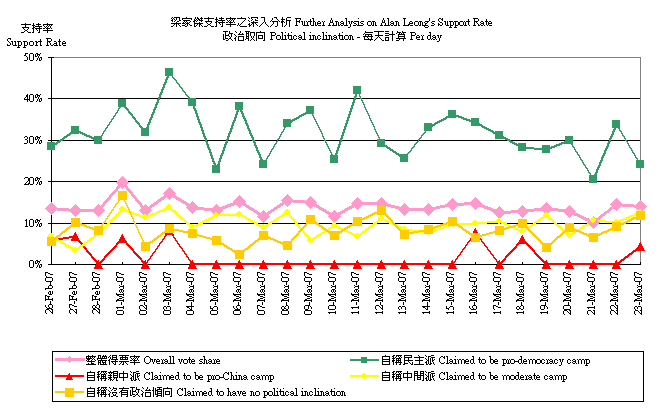HKU POP SITE wraps up findings of CE Election rolling pollBack
|
Press Release on March 26, 2007 |
|
| Special Announcement | Background
| Charts | Commentary | Concluding Remarks | |
| Special Announcement |
|
The Public Opinion Programme (POP) at the University of Hong Kong today releases via the 「HKU POP SITE」 (http://hkupop.pori.hk) figures and analyses of the CE Election rolling polls for the last time, including daily tracking figures. Because the last rolling survey was conducted on March 23, the figures released at the POP Site today are already the final figures of rolling poll series. From today onwards, POP will shift its attention to the appraisal and wrapping-up of the entire election process. Findings will be released in due course. |
|
|
| Background |
|
In 1996, the Public Opinion Programme (POP) at the University of Hong Kong conducted many rounds of surveys on the Chief Executive election, most of which were conducted after Tung Chee-hwa formally announced his intention to stand for the election. During the 2005 CE by-election, because a number of well-known political figures had declared their intention to stand, POP therefore also started our CE election polling routine. Between the end of January and early February this year, both Alan Leong and Donald Tsang embarked on their CE election campaigns, POP therefore switched on our CE election series accordingly. In our three rounds of feature survey, respondents were asked to rate the suitability of Leong and Tsang, as well as to vote hypothetically. The results have already been released long ago. |
|
|
| Charts |
(1) Across the rolling polls from February 26 to March 23, daily changes of Donald Tsang's support rate with respective to respondents' different political inclinations are as follows:
(2) Across the rolling polls from February 26 to March 23, daily changes of Donald Tsang's support rate with respective to respondents' different educational attainment are as follows: 
(3) Across the rolling polls from February 26 to March 23, daily changes of Alan Leong's support rate with respective to respondents' different political inclinations are as follows: 
(4) Across the rolling polls from February 26 to March 23, daily changes of Alan Leong's support rate with respective to respondents' different education attainment are as follows: 
|
|
|
|
|
|
|
|
|
|
|
|
| Special Announcement | Background
| Charts | Commentary | Concluding Remarks
| |







